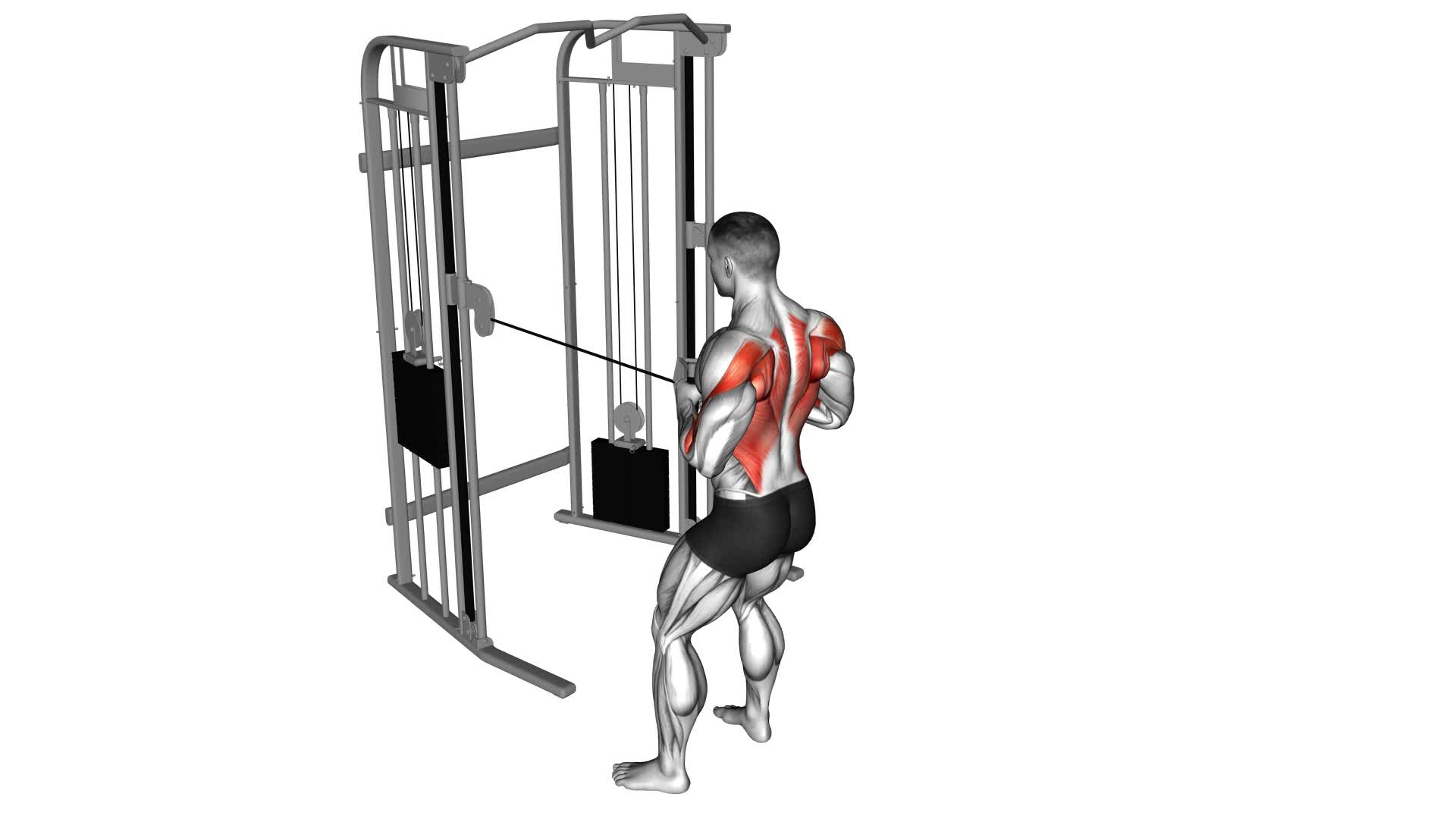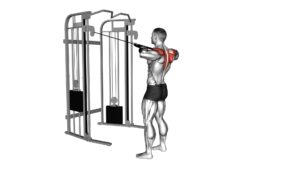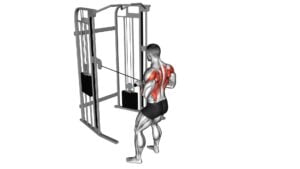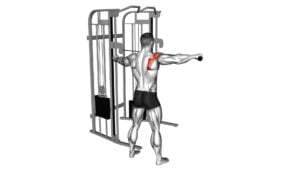Cable Standing Row – Video Exercise Guide & Tips

Are you looking to strengthen your back muscles and improve your posture? Look no further than the cable standing row!
Watch This Exercise Video
This video exercise guide will show you the proper form and technique to get the most out of this exercise.
With just a cable machine and a few simple steps, you can start reaping the benefits of this effective workout.
Get ready to take your fitness to the next level with the cable standing row.
Key Takeaways
- Proper form and technique are crucial for performing the Cable Standing Row effectively without risking injury.
- The Cable Standing Row targets major muscle groups, promotes muscle growth and strength, improves posture, and enhances shoulder stability.
- The exercise can be performed using a cable machine with adjustable pulley system and straight bar attachment, or alternative equipment such as dumbbells, barbells, resistance bands.
- Variations, progressions, and additional tips include adjusting grip, resistance levels, and gradually increasing weight, maintaining proper form and control, setting realistic expectations, staying consistent, and keeping workouts interesting.
Proper Form and Technique
To perform the cable standing row exercise with proper form and technique, start by grabbing the cable handle with a firm grip. Make sure your feet are shoulder-width apart and your knees slightly bent. Keep your back straight and engage your core muscles throughout the exercise.
As you pull the cable towards your body, focus on squeezing your shoulder blades together. This movement should be controlled and smooth, avoiding any jerking or swinging motions. Common mistakes to avoid include using too much weight, rounding your back, and pulling with your arms instead of your back muscles.
By using proper form, you'll maximize muscle activation in your back, particularly in the rhomboids, trapezius, and latissimus dorsi. These muscles play a crucial role in improving posture and upper body strength.
Transitioning into the next section, the cable standing row exercise offers a wide range of benefits for your overall fitness and physique.
Benefits of the Cable Standing Row
Maximize your workout with the cable standing row exercise, as it offers a multitude of benefits for your overall fitness and physique. This exercise is highly effective in muscle activation and back strength development.
The cable standing row targets several major muscle groups, including the latissimus dorsi, rhomboids, and trapezius. By pulling the cable towards your body, you engage these muscles, promoting muscle growth and strength. Additionally, the rowing motion helps to improve your posture by strengthening the muscles that support your spine.
One of the key benefits of the cable standing row is its ability to activate the muscles in your upper back, specifically the rhomboids and trapezius. These muscles play a crucial role in maintaining proper posture and shoulder stability. By strengthening them, you reduce the risk of injuries and improve your overall athletic performance.
Another advantage of the cable standing row is its versatility. You can easily adjust the weight and resistance to match your fitness level, allowing for progressive overload and continuous improvement. This exercise also engages your core muscles, providing a secondary benefit of core stability and strength.
Incorporating cable standing rows into your workout routine can lead to significant improvements in muscle activation and back strength. By consistently performing this exercise, you can achieve a more balanced and defined physique while enhancing your overall fitness level.
Equipment and Set-Up
To set up for the cable standing row exercise, you'll need a cable machine with an adjustable pulley system and a straight bar attachment. The cable machine allows for smooth and controlled movements, while the adjustable pulley system allows you to change the height of the cable to fit your needs. The straight bar attachment provides a secure grip during the exercise.
It's important to note that if you don't have access to a cable machine, there are alternative exercises that can target the same muscle groups. These include bent-over rows with dumbbells or barbells, seated cable rows, or bent-over rows using resistance bands.
When setting up the cable machine for the standing row, make sure the pulley is set at chest height. This will allow for a full range of motion and proper engagement of the back muscles. Additionally, ensure that the weight selected is appropriate for your fitness level and allows you to maintain proper form throughout the exercise.
Now that you understand the equipment and set-up for the cable standing row, let's move on to the step-by-step guide on how to perform the exercise correctly.
Step-by-Step Guide
How do you properly perform the cable standing row exercise?
Here is a step-by-step guide to help you execute this exercise correctly and effectively.
- Start by setting the cable machine to an appropriate weight and attaching a straight bar or handle to the pulley. Adjust the height of the pulley to chest level.
- Stand facing the machine with your feet shoulder-width apart. Grab the bar or handle with an overhand grip, palms facing down.
- Keep your back straight, shoulders back, and core engaged. Take a step back to create tension in the cable.
- Begin the movement by pulling the bar or handle towards your body while keeping your elbows close to your sides. Squeeze your shoulder blades together as you pull.
- Pause for a moment when the bar or handle is close to your torso, then slowly extend your arms to return to the starting position.
- Repeat for the desired number of repetitions.
Common mistakes to avoid during the cable standing row exercise include using excessive weight, rounding the back, and allowing the elbows to flare out. It's important to maintain proper form throughout the exercise to maximize its benefits and prevent injuries.
Variations and Progressions
To add variety and challenge to your cable standing row workout, you can try different variations and progressions. One way to vary your grip is by using a wide grip or a narrow grip. A wide grip targets your upper back muscles, while a narrow grip focuses on your biceps and lower back. Another option is to use an underhand grip, which emphasizes your biceps, or an overhand grip, which targets your upper back. Experimenting with different grips will engage different muscle groups and provide a well-rounded workout.
In addition to varying your grips, you can also adjust the resistance levels to progress your cable standing row workout. Start with a lighter weight and gradually increase as you become stronger and more comfortable with the exercise. Increasing the resistance will challenge your muscles and lead to greater strength gains over time. Remember to maintain proper form and control throughout the movement to maximize the benefits of the exercise.
Tips for Optimal Results
To achieve optimal results with the cable standing row, it's crucial to focus on proper form. This means keeping your back straight, engaging your core, and pulling the cable towards your body using your shoulder muscles.
Additionally, it's important to set realistic expectations for your progress and not compare yourself to others. Remember, consistency is key in any exercise routine, so make sure to incorporate the cable standing row regularly into your workouts for the best results.
Proper Form Importance
Maintain proper form while performing the cable standing row to maximize your results. Proper form is crucial in any exercise because it ensures that you target the right muscles and minimize the risk of injury. Here are some important tips to keep in mind:
- Stand with your feet shoulder-width apart and knees slightly bent.
- Keep your back straight and engage your core throughout the movement.
- Grip the handle with an overhand grip, palms facing down.
- Pull the cable towards your body by squeezing your shoulder blades together.
- Control the movement and slowly return to the starting position.
By following these tips, you'll optimize the effectiveness of the cable standing row and prevent any unnecessary strain on your muscles or joints.
Set Realistic Expectations
To achieve optimal results with the cable standing row, it's important to set realistic expectations and follow these tips.
Managing expectations is crucial because it prevents disappointment and frustration. Understand that progress takes time and effort; you won't see drastic changes overnight. Avoid comparing yourself to others and focus on your own journey.
Additionally, prioritize safety and avoid injury by using proper form and technique. Maintain a neutral spine, engage your core, and keep your shoulders relaxed. Avoid jerking or using momentum to lift the weight, as this can strain your muscles and increase the risk of injury.
By setting realistic expectations and taking precautions to avoid injury, you can maximize your results and progress safely.
Now, let's move on to the next section where we'll discuss why consistency is key.
Consistency Is Key
Stay committed to your fitness routine and make consistency a priority to achieve optimal results with the cable standing row. Consistency is key when it comes to any fitness goal, and it's especially important for this exercise.
Here are some tips to help you maintain motivation and see progress:
- Set realistic goals: Be patient with yourself and understand that results take time.
- Create a schedule: Plan your workouts in advance and stick to them.
- Find an accountability partner: Having someone to hold you accountable can help you stay on track.
- Mix it up: Keep your workouts interesting by incorporating different variations of the cable standing row.
- Celebrate small victories: Recognize and reward yourself for reaching milestones along the way.
Frequently Asked Questions
Can the Cable Standing Row Exercise Be Modified for Individuals With Shoulder Injuries or Limitations?
If you have shoulder injuries or limitations, you may need to modify the cable standing row exercise.
Shoulder rehabilitation is important, so it's crucial to find alternative exercises that won't aggravate your condition.
It's best to consult with a physical therapist or an exercise professional who can provide specific recommendations tailored to your needs.
They can guide you on exercises that will strengthen your shoulders without causing further harm or discomfort.
How Often Should the Cable Standing Row Exercise Be Performed in a Weekly Workout Routine?
To maximize the benefits of the cable standing row exercise, it's important to consider the frequency in your weekly workout routine.
Without the context of the Cable Standing Row – Video Exercise Guide & Tips, let's focus on the cable standing row frequency.
It's recommended to perform this exercise 2-3 times a week, allowing for adequate rest days in between.
Can the Cable Standing Row Exercise Help Improve Posture?
The cable standing row exercise can definitely help improve your posture. By targeting your back muscles, it helps strengthen and stabilize your upper body, which can lead to better posture.
To get the most benefit, make sure you use proper form for the cable standing row. Keep your back straight, engage your core, and pull the cable towards your body, squeezing your shoulder blades together.
This exercise is a great addition to your routine for posture improvement.
Are There Any Common Mistakes to Avoid While Performing the Cable Standing Row Exercise?
When doing the cable standing row exercise, it's important to be aware of some common mistakes to avoid. Proper form is crucial to prevent injury and get the most out of the exercise.
One mistake to watch out for is rounding your back. Keep your spine straight and engage your core.
Another mistake is using too much weight. Start with a lighter weight and focus on proper technique before increasing resistance.
Can the Cable Standing Row Exercise Be Incorporated Into a Full-Body Workout Routine?
Yes, the cable standing row exercise can definitely be incorporated into a full-body workout routine. It's a great exercise for improving shoulder stability and back strength. By targeting multiple muscle groups at once, it helps to enhance overall upper body strength and posture.
Adding the cable standing row to your workout routine will provide a challenging and effective way to work your back muscles while also engaging your core and arms.
Conclusion
In conclusion, the cable standing row is an effective exercise for building upper body strength and improving posture.
By maintaining proper form and technique, you can maximize the benefits of this exercise.
Whether you're a beginner or advanced, there are variations and progressions available to challenge yourself.
Remember to always use the appropriate equipment and set up before starting the exercise.
Follow these tips for optimal results and enjoy the benefits of the cable standing row.

Author
Years ago, the spark of my life’s passion ignited in my mind the moment I stepped into the local gym for the first time. The inaugural bead of perspiration, the initial endeavor, the very first surge of endorphins, and a sense of pride that washed over me post-workout marked the beginning of my deep-seated interest in strength sports, fitness, and sports nutrition. This very curiosity blossomed rapidly into a profound fascination, propelling me to earn a Master’s degree in Physical Education from the Academy of Physical Education in Krakow, followed by a Sports Manager diploma from the Jagiellonian University. My journey of growth led me to gain more specialized qualifications, such as being a certified personal trainer with a focus on sports dietetics, a lifeguard, and an instructor for wellness and corrective gymnastics. Theoretical knowledge paired seamlessly with practical experience, reinforcing my belief that the transformation of individuals under my guidance was also a reflection of my personal growth. This belief holds true even today. Each day, I strive to push the boundaries and explore new realms. These realms gently elevate me to greater heights. The unique combination of passion for my field and the continuous quest for growth fuels my drive to break new ground.







